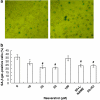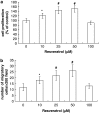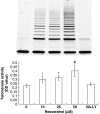Resveratrol reduces endothelial progenitor cells senescence through augmentation of telomerase activity by Akt-dependent mechanisms
- PMID: 18587418
- PMCID: PMC2567879
- DOI: 10.1038/bjp.2008.272
Resveratrol reduces endothelial progenitor cells senescence through augmentation of telomerase activity by Akt-dependent mechanisms
Abstract
Background and purpose: Recent studies have shown that resveratrol increased endothelial progenitor cells (EPCs) numbers and functional activity. However, the mechanisms remain to be determined. Previous studies have demonstrated that increased EPC numbers and activity were associated with the inhibition of EPC senescence, which involves activation of telomerase. Therefore, we investigated whether resveratrol inhibits the onset of EPC senescence through telomerase activation, leading to potentiation of cellular activity.
Experimental approach: After prolonged in vitro cultivation, EPCs were incubated with or without resveratrol. The senescence of EPCs were determined by acidic beta-galactosidase staining. The bromo-deoxyuridine incorporation assay or a modified Boyden chamber assay were employed to assess proliferative or migratory capacity, respectively. To further examine the underlying mechanisms of these effects, we measured telomerase activity and the phosphorylation of Akt by western blotting.
Key results: Resveratrol dose dependently prevented the onset of EPCs senescence and increased the proliferation and migration of EPCs. The effect of resveratrol on senescence could not be abolished by eNOS inhibitor or by an oestrogenic receptor antagonist. Resveratrol significantly increased telomerase activity and Akt phosphorylation. Pre-treatment with the PI3K inhibitor, LY294002, significantly attenuated resveratrol-induced telomerase activity.
Conclusions and implications: Resveratrol delayed the onset of EPC senescence and this effect was accompanied by activation of telomerase through the PI3K-Akt signalling pathway. The inhibition of EPCs senescence by resveratrol might protect EPCs against dysfunction induced by pathological factors in vivo and improve EPC functional activities in a way that may be important for cell therapy.
Figures






Similar articles
-
Nicotine-reduced endothelial progenitor cell senescence through augmentation of telomerase activity via the PI3K/Akt pathway.Cytotherapy. 2009;11(4):485-91. doi: 10.1080/14653240902887267. Cytotherapy. 2009. PMID: 19499400
-
Puerarin reduces endothelial progenitor cells senescence through augmentation of telomerase activity.Vascul Pharmacol. 2008 Aug-Sep;49(2-3):106-10. doi: 10.1016/j.vph.2008.07.002. Epub 2008 Jul 20. Vascul Pharmacol. 2008. PMID: 18692596
-
Estrogen reduces endothelial progenitor cell senescence through augmentation of telomerase activity.J Hypertens. 2005 Sep;23(9):1699-706. doi: 10.1097/01.hjh.0000176788.12376.20. J Hypertens. 2005. PMID: 16093915
-
Effect of resveratrol on endothelial cell function: Molecular mechanisms.Biofactors. 2010 Sep-Oct;36(5):342-9. doi: 10.1002/biof.109. Biofactors. 2010. PMID: 20730905 Review.
-
Endothelial precursor cells.Stem Cell Rev. 2007 Fall;3(3):218-25. doi: 10.1007/s12015-007-0007-5. Stem Cell Rev. 2007. PMID: 17917135 Review.
Cited by
-
Hormesis and Endothelial Progenitor Cells.Dose Response. 2022 Feb 23;20(1):15593258211068625. doi: 10.1177/15593258211068625. eCollection 2022 Jan-Mar. Dose Response. 2022. PMID: 35221821 Free PMC article. Review.
-
Healthy aging and disease: role for telomere biology?Clin Sci (Lond). 2011 May;120(10):427-40. doi: 10.1042/CS20100385. Clin Sci (Lond). 2011. PMID: 21271986 Free PMC article. Review.
-
Endothelial Colony-Forming Cells Dysfunctions Are Associated with Arterial Hypertension in a Rat Model of Intrauterine Growth Restriction.Int J Mol Sci. 2021 Sep 21;22(18):10159. doi: 10.3390/ijms221810159. Int J Mol Sci. 2021. PMID: 34576323 Free PMC article.
-
Senescent endothelial progenitor cells from dogs with pulmonary arterial hypertension: a before-after self-controlled study.J Physiol Sci. 2009 Nov;59(6):429-37. doi: 10.1007/s12576-009-0053-7. Epub 2009 Jul 28. J Physiol Sci. 2009. PMID: 19636669 Free PMC article.
-
Opportunities and challenges of foodborne polyphenols applied to anti-aging health foods.Food Sci Biotechnol. 2024 Sep 7;33(15):3445-3461. doi: 10.1007/s10068-024-01686-x. eCollection 2024 Dec. Food Sci Biotechnol. 2024. PMID: 39493397 Review.
References
-
- Asahara T, Murohara T, Sullivan A, Silver M, van der Zee R, Li T, et al. Isolation of putative endothelial progenitor cells for angiogenesis. Science. 1997;275:964–967. - PubMed
-
- Ashby J, Tinwell H, Pennie W, Brooks AN, Lefevre PA, Beresford N, et al. Partial and weak oestrogenicity of the red wine constituent resveratrol: consideration of its superagonist activity in MCF-7 cells and its suggested cardiovascular protective effects. J Appl Toxicol. 1999;19:39–45. - PubMed
-
- Assmus B, Honold J, Schächinger V, Britten MB, Fischer-Rasokat U, Lehmann R, et al. Transcoronary transplantation of progenitor cells after myocardial infarction. N Engl J Med. 2006;355:1222–1232. - PubMed
-
- Assmus B, Urbich C, Aicher A, Hofmann WK, Haendeler J, Rössig L, et al. HMG-CoA reductase inhibitors reduce senescence and increase proliferation of endothelial progenitor cells via regulation of cell cycle regulatory genes. Circ Res. 2003;92:1049–1055. - PubMed
MeSH terms
Substances
LinkOut - more resources
Full Text Sources
Other Literature Sources

